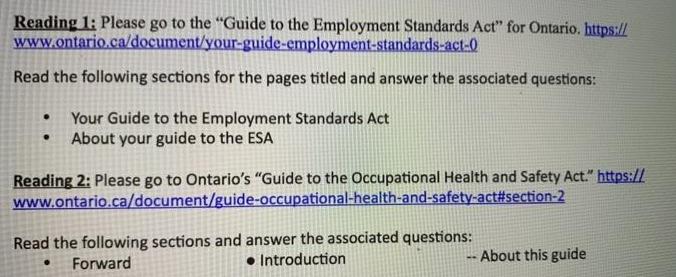Answered step by step
Verified Expert Solution
Question
1 Approved Answer
Reading 1: Please go to the Guide to the Employment Standards Act for Ontario. https:// www.ontario.ca/document/your-guide-employment-standards-act-0 Read the following sections for the pages titled




Reading 1: Please go to the "Guide to the Employment Standards Act" for Ontario. https:// www.ontario.ca/document/your-guide-employment-standards-act-0 Read the following sections for the pages titled and answer the associated questions: Your Guide to the Employment Standards Act About your guide to the ESA Reading 2: Please go to Ontario's "Guide to the Occupational Health and Safety Act." https:// www.ontario.ca/document/guide-occupational-health-and-safety-act#section-2 Read the following sections and answer the associated questions: Forward Introduction About this guide Assignment #2 Paraphrasing & Summarizing Assignment (10%)-Written Portion-Part B ESOL 120 **1.) What is your purpose for reading these texts and writing this assignment? Who is your intended audience? /3 Hint: Purpose-Why are you answering these questions/completing this assignment? What learning processes are you using? What skills are you practicing? Hint: Audience-While I am your audience, explain why that matters to you, as the writer. In other words, how and why will you adapt your writing for me (as your audience)? What vocabulary will you use? What writing structure? Content? Etc.? **2.) What is the difference between an employee and an employer? If you use another source to help you with this information, make sure you cite your source properly! /3 Hint: You can use a general definition for these terms. What font will you use when you are defining a word? What signal word(s) will you use for definition and comparison/contrast? 3.) What is the purpose of the Employment Standards Act (ESA) and the Occupational Health and Safety Act (OHSA)? /6 Hint: How will you introduce the name of each act and the abbreviation? What signal word(s) will you use for comparison/contrast? Don't forget to paraphrase/summarize the answer and include in-text citations! 4.) How should these guides be used? How should these guides not be used? /9 Hint: What is the purpose of these guides? Why were they created? What can these guides help you to do or know? Why do you still need to view the act and not rely only on the guides? What signal word(s) will you use to show the relationship of ideas? How will you organize your ideas for this answer? Don't forget to paraphrase/summarize the answer and include in-text citations! 5.) What are two main differences between the guides and the acts themselves? /6 Hint: Think about content/level of detail, style of writing, audience, etc. What signal word(s) will you use to show the relationship of ideas? Don't forget to paraphrase/summarize the answer and include in-text citations! **6.) Who do you think the intended audience for these guides are? Make an informed decision about one or two specific groups of people (eg. Teachers, contractors, politicians, Canadians, students, etc.) who might read these guides. Why do you think these guides are for this particular audience? Provide specific examples from the guides (or from your notes) for your reasoning. Remember, think about language use, level of detail, content, writing style, definitions, etc. /3 Hint: Make an informed decision here. Just like when you write and consider your audience, think about who these guides were written for. You can break this down in to the following categories: High-level of expertise on the topic (H), Mid-level of expertise on the topic (M), low-level of expertise on the topic (L). To consider what category, think about how much the reader knows about the topic and how much the reader needs to know for the author to achieve his/her purpose. Has the author included jargon (technical words specific to the discipline and if so, has the author provided a glossary or definitions for those words?) Has the author provided a concept in basic terms, or has the author included details facts and figures without explanation? Decide on the group and provide one or two reasons why. **7.) Look at the currency and authority for these guides. Based on currency and authority only, would you consider these guides to be credible sources for a first-year Humber student completing a research project on employee rights in Ontario Workplaces? Provide 2 or 3 reasons why you would or would not use these guides and explain your reasoning. Answer this question in proper paragraph structure. /10 Hint:. Review the learning materials relating to evaluating sources. Focus on currency and authority. Make sure you elaborate on why and provide evidence. For example, if you say that a guide was revised in 2016, why does that matter? Why is that current enough? Why does currency matter in that context?
Step by Step Solution
★★★★★
3.37 Rating (150 Votes )
There are 3 Steps involved in it
Step: 1
1 Purpose and Intended Audience The purpose of reading these texts and writing this assignment is to gain a comprehensive understanding of the Employment Standards Act ESA and the Occupational Health ...
Get Instant Access to Expert-Tailored Solutions
See step-by-step solutions with expert insights and AI powered tools for academic success
Step: 2

Step: 3

Ace Your Homework with AI
Get the answers you need in no time with our AI-driven, step-by-step assistance
Get Started


